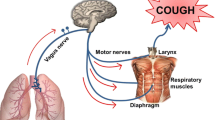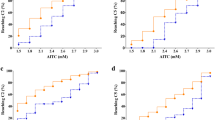Abstract
This article expands the author’s presentation at the First American Cough Conference in New York City, June 8–9, 2007. The results of a scientific literature search and application of personal research findings are included. A new hypothesis to explain irritant-induced cough as a being a dysfunction of the transient receptor potential vanilloid 1 (TRPV1) cation channels located in pulmonary excitable cells is presented. The TRPV1 cation channels regulate cellular transmembrane voltage by raising intracellular Ca2+ and Na+ concentrations and depolarizing sensory nerve cells containing C-fibers. The discussion centers on the “capsaicin receptor” (TRPV1) and another important ion channel, TRPA1. The author reviews results of published scientific investigations to support his contention that neural events, initiated by TRPV1 ion channels, lead to a cascade of alterations that progress to a cough endpoint. A potential mechanism to explain chronic cough in conditions where there is repeated or severe irritant-induced airway epithelial injury (e.g., RADS) is through persistent TRPV1 channel activation (e.g., TRPV1pathy) with accumulation of inflammatory mediators, tachykinins, and the release of neurotrophins leading to persistent cough and airway inflammation. The significance of the hypothesis is that, if proven, it may provide new therapeutic approaches for the treatment of chronic cough.


Similar content being viewed by others
References
Online Medical Dictionary, Stedman’s Medical Dictionary, 27th ed. Baltimore: Lippincott Williams and Wilkins, 2007
Shusterman D (2004) Sequel of respiratory tract exposures to irritants. (PCCU) Pulmonary and critical care update. Lesson 2, Volume 15, December 31, 2004. Website: http://chestnet.org/education/online/pccu/vol15/lesson1_2/lesson02.php
Occupational Safety and Health Administration (OSHA) (1994) The OSHA hazard communication standard (HCS)
Safety, Environment Unit (2007) Glossary of Chemical Terms. Rehovot, Israel: Weizmann Institute of Science. Website:http://www.weizmann.ac.il/safety/chgl.htm
Randle WM, Bussard ML (1993) Streamlining onion pungency analyses. Hort Sci 28:60
Brooks SM (2007) Inhalation airway injury: A spectrum of changes. Clin Pulm Med 14(6):330–337
Green BG, Schullery MT (2003) Stimulation of bitterness by capsaicin and menthol: differences between lingual areas innervated by the glossopharyngeal and chorda tympani nerves. Chem Senses 28:45–55
Dicpinigaitis PV (2003) Short- and long-term reproducibility of capsaicin cough challenge testing. Pulm Pharmacol Ther 16:61–65
Dicpinigaitis PV (2003) Cough reflex sensitivity in cigarette smokers. Chest 123:685–688
Barber CM, Curran AD, Fishwick D (2003) Impaired cough reflex in patients with recurrent pneumonia. Thorax 58:645–646
Kastelik JA, Thompson RH, Aziz I, Ojoo JC, Redington AE, Morice AH (2002) Sex-related differences in cough reflex sensitivity in patients with chronic cough. Am J Respir Crit Care Med 166:961–964
Nieto L, deDiego A, Perpina M, et al. (2003) Cough reflex testing with inhaled capsaicin in the study of chronic cough. Respir Med 97:393–400
Morice AH, Kastelik JA, Thompson R (2001) Cough challenge in the assessment of cough reflex. Br J Clin Pharmacol 52:365–375
Dicpinigaitis PV (2001) Capsaicin responsiveness in asthma and COPD. Thorax 56:162–164
Prescott J, Swain-Campbell N (2000) Responses to repeated oral irritation by capsaicin, cinnamaldehyde and ethanol in PROP tasters and non-tasters. Chem Senses 25:239–246
Millqvist E (2000) Cough provocation with capsaicin is an objective way to test sensory hyperreactivity in patients with asthma-like symptoms. Allergy 55:546–550
Doherty MJ, Mister R, Pearson MG, Calverley PM (2000) Capsaicin induced cough in cryptogenic fibrosing alveolitis. Thorax 55:1028–1032
Hathaway TJ, Higenbottam TW, Morrison JF, Clelland CA, Wallwork J (1993) Effects of inhaled capsaicin in heart-lung transplant patients and asthmatic subjects. Am Rev Respir Dis 148:1233–1237
Midgren B, Hansson B, Karlsson J-A, Simonsson BG, Persson CG (1992) Capsaicin-induced cough in humans. Am Rev Respir Dis 146:347–351
Hansson L, Wollmer P, Dahlback M, Karlsson JA (1992) Regional sensitivity of human airways to capsaicin-induced cough. Amer Rev Respir Dis 145:1191–1195
Stjarne P, Lundblad L, Lundberg JM, Anggård A (1989) Capsaicin and nicotine-sensitive afferent neurones and nasal secretion in healthy human volunteers and in patients with vasomotor rhinitis. Br J Pharmacol 96:693–701
Szallasi A, Blumberg PM (1999) Vanilloid (Capsaicin) receptors and mechanisms. Pharmacol Rev 51:159–212
Huang C-L (2004) The transient receptor potential superfamily of ion channels. J Am Soc Nephrol 15:1690–1699
Rohacs T, Nilius B (2007) Regulation of transient receptor potential (TRP) channels by phosphoinositides. Pflugers Arch 455:157–168
Ramsey IS, Delling M, Clapham DE (2006) An introduction to TRP channels. Annu Rev Physiol 68:619–647
Taylor-Clark T, Undem BJ (2006) Transduction mechanisms in airway sensory nerves. J Appl Physiol 101:950–959
Nilius B, Voets T, Peters J (2005) TRP channels in disease. Sci STKE 295:1–9
Tatar M, Pecova R (1996) The effect of experimental gastroesophageal reflux on the cough reflex in anesthetized cats. Bratisl Lek Listy 97:284–288
Wong CH, Matai R, Morice AH (1999) Cough induced by low pH. Respir Med 93:58–61
Clapham DE (2003) TRP channels as cellular sensors. Nature 426:517–524
Mazzone SB, McLennan L, McGovern AE, Egan GF, Farrell MJ (2007) Representation of capsaicin-evoked urge to cough in the human brain using functional magnetic resonance imaging. Am J Respir Crit Care Med 176:327–332
Canning BJ, Farmer DG, Mori N (2006) Mechanistic studies of acid-evoked coughing in anesthetized guinea pigs. Am J Physiol Regul Integr Comp Physiol 291:R454–R463
Groneberg DA, Niimi A, Dinh QT, Cosio B, Hew M, Fischer A, Chung KF (2004) Increased expression of transient receptor potential vanilloid-1 in airway nerves of chronic cough. Am J Respir Crit Care Med 170:1276–1280
LeVan TD, Koh W-P, Lee H-P, Koh D, Yu MC, London SJ (2006) Vapor, dust, and smoke exposure in relation to adult-onset asthma and chronic respiratory symptoms. The Singapore Chinese Health Study. Am J Epidemiol 163:1118–1128
Tarlo SM (2006) Cough: occupational and environmental considerations. ACCP evidence-based clinical practice guidelines. Chest 129:186–196
American Thoracic Society (2003) Occupational contribution to the burden of airway disease. Am J Respir Crit Care Med 167:787–797
Cain WS, Cometto-Muniz JE (1995) Irritation and odor as indicators of indoor pollution. Occup Med 10:133–145
Trupin L, Earnest G, SanPedro M, Balmes JR, Eisner MD, Yelin E, Katz PP, Blanc PD (2003) The occupational burden of chronic obstructive pulmonary disease. Eur Respir J 22:462-469
Tanaka H, Saikai T, Sugawara H, Takeya I, Tsunematsu K, Matsuura A, Abe S (2002) Workplace-related chronic cough on a mushroom farm. Chest 122:1080–1085
Minnette A (1989) Questionnaire of the European Community for Coal and Steel (ECSC) on respiratory symptoms. 1987–updating of the 1962 and 1967 questionnaires for studying chronic bronchitis and emphysema. Eur J Respir Dis 2:165–177
Mustajbegovic J, Zuskin E, Schachter EN, Kern J, Vrcic-Keglevic M, Vitale K, Ebling Z (2001) Respiratory findings in livestock farmworkers. J Occup Environ Med 43:576–584
Groneberg DA, Nowak D, Wussow A, Fischer A (2006) Chronic cough due to occupational factors. J Occup Med Toxicol 1:3
Gordon SB, Curran AD, Turley A, Wong CH, Rahman SN, Wiley K, Morice AH (1997) Glass bottle workers exposed to low-dose irritant fumes cough but do not wheeze. Am J Respir Criti Care Med 156:206–210
Gordon SB, Curran AD, Fishwick D et al. (1998) Respiratory symptoms among glass bottle workers–cough and airways irritancy syndrome? Occup Med 48: 455–459
Blanc P, Liu D, Juarez C, Boushey HA (1991) Cough in hot pepper workers. Chest 99:27–32
Bautista DM, Movahed P, Hinman A, Axelsson HE, Sterner O, Högestätt ED, Julius D, Jordt SE, Zygmunt PM (2005) Pungent products from garlic activate the sensory ion channel TRPA1. Proc Natl Acad Sci U S A 102:12248–12252
Obata K, JKatsura H, Mizushima T, Yamanaka H, Kobayashi K, Dai Y, Fukuoka T, Tokunaga A, Tominaga M, Noguchi K (2005) TRPA1 induced in sensory neurons contribute to cold hyperalgesia after inflammation and nerve injury. J Clin Invest 115:2393–2401
Trevisani M, Siemens J, Materazzi S, Bautista DM, Nassini R, Campi B, Imamachi N, Andrè E, Patacchini R, Cottrell GS, Gatti R, Basbaum AI, Bunnett NW, Julius D, Geppetti P (2007) 4-Hydroxynonenal, an endogenous aldehyde, causes pain and neurogenic inflammation through activation of the irritant receptor TRPA1. Proc Natl Acad Sci U S A 104:13519–13524
McNamara CR, Mandel-Brehm J, Bautista DM, Siemens J, Deranian KL, Zhao M, Hayward NJ, Chong JA, Julius D, Moran MM, Fanger CM (2007) TRPA1 mediates formalin-induced pain. Proc Natl Acad Sci U S A 104:13525–13530
Story GM, Peier AM, Reeve AJ, Eld SR, Mosbacher J, Hricik TR, Earley TJ, Hergarden AC, Andersson DA, Hwang SW, McIntyre P, Jegla T, Bevan S, Patapoutian A (2003) ANKTM1, a TRP-like channel expressed in nociceptive neurons, is activated by cold temperatures. Cell 112:819–829
Story GM, Gereau RW (2006) Numbing the senses: Role of TRPA1 in mechanical and cold sensation. Neuron 50:177–179
Dai Y, Wang S, Tominaga M, Yamamoto S, Fukuoka T, Higashi T, Kobayashi K, Obata K, Yamanaka H, Noguchi K (2007) Sensitization of TRPA1 by PARS2 contributes to sensation of inflammatory pain. J Clin Invest 117:1979–1989
Macpherson LJ, Dubin AE, Evans MJ, Marr R, Schultz PG, Cravatt BF, Patapoutian A (2007) Noxious compounds activate TRPA1 ion channels through covalent modification of cysteines. Nature 445:541–545
Kiselyov K, Soyombo A, Muallem S (2007) TRPpathies. J Physiol 578(Pt 3):641–653
Groneberg DA, Quarcoo D, Frossard N, Fischer A (2004) Neurogenic mechanisms in bronchial inflammatory diseases. Allergy 59:1139–1152
Gatti R, Andre E, Amadesi S, Dinh TQ, Fischer A, Bunnett NW, Harrison S, Geppetti P, Trevisani M (2006) Protease-activated receptor-2 exaggerates TRPV1-mediated cough in guinea pigs. J Appl Physiol 101:506–511
Author information
Authors and Affiliations
Corresponding author
Rights and permissions
About this article
Cite this article
Brooks, S.M. Irritant-Induced Chronic Cough: Irritant-Induced TRPpathy. Lung 186 (Suppl 1), 88–93 (2008). https://doi.org/10.1007/s00408-007-9068-0
Received:
Accepted:
Published:
Issue Date:
DOI: https://doi.org/10.1007/s00408-007-9068-0




